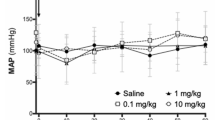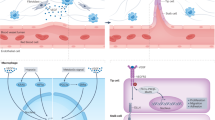Abstract
The growth and persistence of solid tumors and their metastasis are angiogenesis-dependent. Vasostatin, the N-terminal domain of calreticulin inclusive of amino acids 1–180, is a potent angiogenesis inhibitor. To investigate whether intramuscular administration of vasostatin gene has the antitumor activity in mouse tumor models, we constructed a plasmid DNA encoding vasostatin and a control vector. Production and secretion of vasostatin protein by COS cells transfected with the plasmid DNA encoding vasostatin (pSecTag2B-vaso) were confirmed by Western blot analysis and ELISA. Conditioned medium from vasostatin-transfected COS cells apparently inhibited human umbilical vein endothelial cell (HUVEC) and mouse endothelial cell (SVEC4-10) proliferation, compared with conditioned medium from the COS cells transfected with control vector or non-transfected cells. Treatment with pSecTag2B-vaso twice weekly for 4 weeks resulted in the inhibition of tumor growth and the prolongation of the survival of tumor-bearing mice. The sustained high level of vasostatin protein in serum could be identified in ELISA. Angiogenesis was apparently inhibited in tumor by immunohistochemical analysis. Angiogenesis was also inhibited in the chicken embryo CAM assay and mouse corneal micropocket assay. The increased apoptotic cells were found within the tumor tissues from the mice treated with plasmid DNA encoding vasostatin. Taken together, the data in the present study indicate that the cancer gene therapy by the intramuscular delivery of plasmid DNA encoding vasostatin, is effective in the inhibition of the systemic angiogenesis and tumor growth in murine models. The present findings also provide further evidence of the anti-tumor effects of the vasostatin, and may be of importance for the further exploration of the application of this molecule in the treatment of cancer.
This is a preview of subscription content, access via your institution
Access options
Subscribe to this journal
Receive 12 print issues and online access
$259.00 per year
only $21.58 per issue
Buy this article
- Purchase on Springer Link
- Instant access to full article PDF
Prices may be subject to local taxes which are calculated during checkout






Similar content being viewed by others
References
Folkman J . Tumor angiogenesis: therapeutic implications N Engl J Med 1971 285: 1182–1186
Gasparini G . The rationale and future potential of angiogenesis inhibitors in neoplasia Drugs 1999 58: 17–38
Wei YQ et al. Immunotherapy of tumors with xenogeneic endothelial cells as a vaccine Nat Med 2000 6: 1160–1166
Folkman J . What is the evidence that tumors are angiogenesis dependent? J Natl Cancer Inst 1990 82: 4–6
Ferrara N, Alitalo K . Clinical applications of angiogenic growth factors and their inhibitors Nat Med 1999 5: 1359–1364
Risau W . Mechanisms of angiogenesis Nature 1997 386: 671–674
Sacco MG et al. Systemic gene therapy with anti-angiogenic factors inhibits spontaneous breast tumor growth and metastasis in MMTVneu transgenic mice Gene Therapy 2001 8: 67–70
Cao R et al. Suppression of angiogenesis and tumor growth by the inhibitor K1-5 generated by plasmin-mediated proteolysis Proc Natl Acad Sci USA 1999 96: 5728–5733
O'Reilly MS et al. Endostatin: an endogenous inhibitor of angiogenesis and tumor growth Cell 1997 88: 277–285
Kerbel RS . A cancer therapy resistant to resistance Nature 1997 390: 335–336
Fidler IJ, Ellis LM . The implications of angiogenesis for the biology and therapy of cancer metastasis Cell 1994 79: 185–188
Arap W, Pasqualini R, Ruoslahti E . Cancer treatment by targeted drug delivery to tumor vasculature in a mouse model Science 1998 279: 377–380
Pike SE et al. Vasostatin, a calreticulin fragment, inhibits angiogenesis and suppresses tumor growth J Exp Med 1998 188: 2349–2356
Pike SE et al. Calreticulin and calreticulin fragments are endothelial cell inhibitors that suppress tumor growth Blood 1999 94: 2461–2468
Yao L et al. Effective targeting of tumor vasculature by the angiogenesis inhibitors vasostatin and interleukin-2 Blood 2000 96: 1900–1905
Lohr F et al. Effective tumor therapy with plasmid-encoded cytokines combined with in vivo electroporation Cancer Res 2001 61: 3281–3284
Chen Q-R, Kumar D, Stass S-A, Mixson A-J . Liposomes complexed to plasmids encoding angiostatin and endostatin inhibit breast cancer in nude mice Cancer Res 1999 59: 3308–3312
Blezinger P et al. Systemic inhibition of tumor growth and tumor metastases by intramuscular administration of the endostatin gene Nat Biotechnol 1999 17: 343–348
Horton HM et al. A gene therapy for cancer using intramuscular injection of plasmid DNA encoding interferon alpha Proc Natl Acad Sci USA 1999 96: 1553–1558
Griffioen AW, Molema G . Angiogenesis: potentials for pharmacologic intervention in the treatment of cancer, cardiovascular diseases, and chronic inflammation Pharmacol Rev 2000 52: 237–268
O'Reilly MS et al. Angiostatin: a novel angiogenesis inhibitor that mediates the suppression of metastases by a Lewis lung carcinoma Cell 1994 79: 315–328
Gupta SK, Hassel T, Singh JP . A potent inhibitor of endothelial cell proliferation is generated by proteolytic cleavage of the chemokine platelet factor 4 Proc Natl Acad Sci USA 1995 92: 7799–7803
Kolber D-L, Knisely T-L, Maione T-E . Inhibition of development of murine melanoma lung metastases by systemic administration of recombinant platelet factor 4 J Natl Cancer Inst 1995 87: 304–309
Ramchandran R et al. Antiangiogenic activity of restin, NC10 domain of human collagen XV: comparison to endostatin Biochem Biophys Res Commun 1999 255: 735–739
Rastinejad F, Polverini PJ, Bouck NP . Regulation of the activity of a new inhibitor of angiogenesis by a cancer suppressor gene Cell 1989 56: 345–355
Gorrin-Rivas MJ et al. Mouse macrophage metalloelastase gene transfer into a murine melanoma suppresses primary tumor growth by halting angiogenesis Clin Cancer Res 2000 6: 1647–1654
Feldman AL et al. Antiangiogenic gene therapy of cancer utilizing a recombinant adenovirus to elevate systemic endostatin levels in mice Cancer Res 2000 60: 1503–1506
Sauter BV et al. Adenovirus-mediated gene transfer of endostatin in vivo results in high level of transgene expression and inhibition of tumor growth and metastases Proc Natl Acad Sci USA 2000 97: 4802–4807
Roth JA, Cristiano RJ . Gene therapy for cancer: what have we done and where are we going? J Natl Cancer Inst 1997 89: 21–39
Lehrman S . Rockefeller head warns of backlash Nature 1999 401: 831–832
Fox JA . Gene therapy safety issues come to fore Nat Biotechnol 1999 17: 1153
Schatzlein A-G . Non-viral vectors in cancer gene therapy: principles and progress Anticancer Drug 2001 12: 275–304
Tripathy SK et al. Long-term expression of erythropoietin in the systemic circulation of mice after intramuscular injection of a plasmid DNA vector Proc Natl Acad Sci USA 1996 93: 10876–10880
Schofield J-P, Caskey C-T . Non-viral approaches to gene therapy Br Med Bull 1995 51: 56–71
Davis HL et al. Plasmid DNA is superior to viral vectors for direct gene transfer into adult mouse skeletal muscle Hum Gene Ther 1993 4: 733–740
Wei YQ et al. Immunogene therapy of tumors with vaccine based on Xenopus homologousvascular endothelial growth factor as a model antigen Proc Natl Acad Sci USA 2001 98: 11545–11550
Krieg AM et al. Sequence motifs in adenoviral DNA block immune activation by stimulatory CpG motifs Proc Natl Acad Sci USA 1998 95: 12631–12636
Stacker SA et al. A mutant form of vascular endothelial growth factor (VEGF) that lacks VEGF receptor-2 activation retains the ability to induce vascular permeability J Biol Chem 1999 274: 34884–34892
Lou YY et al. Immunogene therapy of tumor with vaccine based on the ligand-binding domain of chicken homologous integrin β3 Immunol Invest 2002 31: 51–69
Colman RW et al. Domain 5 of high molecular weight kininogen (kininostatin) down-regulates endothelial cell proliferation and migration and inhibits angiogenesis Blood 2000 95: 543–550
van der Schaft D-W et al. Bactericidal/permeability-increasing protein (BPI) inhibits angiogenesis via induction of apoptosis in vascular endothelial cells Blood 2000 96: 176–181
Drixler TA et al. Continous administration of angiostatin inhibits accelerated growth of colorectal liver metastases after partial hepatectomy Cancer Res 2000 60: 1761–1765
Wei YQ, Hang ZB, Liu KF . In situ observation of inflammatory cell-tumor cell interaction in human seminomas (germinomas): light, electron microscopic, and immunohistochemical study Hum Pathol 1992 23: 421–428
Holmgren L, O'Reilly M-S, Folkman J . Dormancy of micrometastases: balanced proliferation and apoptosis in the presence of angiogenesis suppression Nat Med 1995 1: 149–153
Acknowledgements
Authors thank Dr Xuebiao Yao (University of California, Berkeley) for helpful review of the manuscript. This work is supported by Special Project of National Key Basic Research Program of China (No. 2001-50) and National Key Basic Research Program of China (2001CB510001), Project of National Natural Sciences Foundation of China (30130260 and 30070294), Key University Teacher Foundation and Student Association Foundation of Sasakawa Medical Scholarship.
Author information
Authors and Affiliations
Rights and permissions
About this article
Cite this article
Xiao, F., Wei, Y., Yang, L. et al. A gene therapy for cancer based on the angiogenesis inhibitor, vasostatin. Gene Ther 9, 1207–1213 (2002). https://doi.org/10.1038/sj.gt.3301788
Received:
Accepted:
Published:
Issue Date:
DOI: https://doi.org/10.1038/sj.gt.3301788
Keywords
This article is cited by
-
AAV-mediated gene delivery of the calreticulin anti-angiogenic domain inhibits ocular neovascularization
Angiogenesis (2018)
-
Plasmid-encoding vasostatin inhibited the growth and metastasis of human hepatocellular carcinoma cells
Molecular and Cellular Biochemistry (2014)
-
Anti-angiogenesis therapy based on the bone marrow-derived stromal cells genetically engineered to express sFlt-1 in mouse tumor model
BMC Cancer (2008)
-
A Tumor-selective Biotherapy With Prolonged Impact on Established Metastases Based on Cytokine Gene-engineered MSCs
Molecular Therapy (2008)
-
A Tumor-selective Biotherapy With Prolonged Impact on Established Metastases Based on Cytokine Gene-engineered MSCs
Molecular Therapy (2008)



